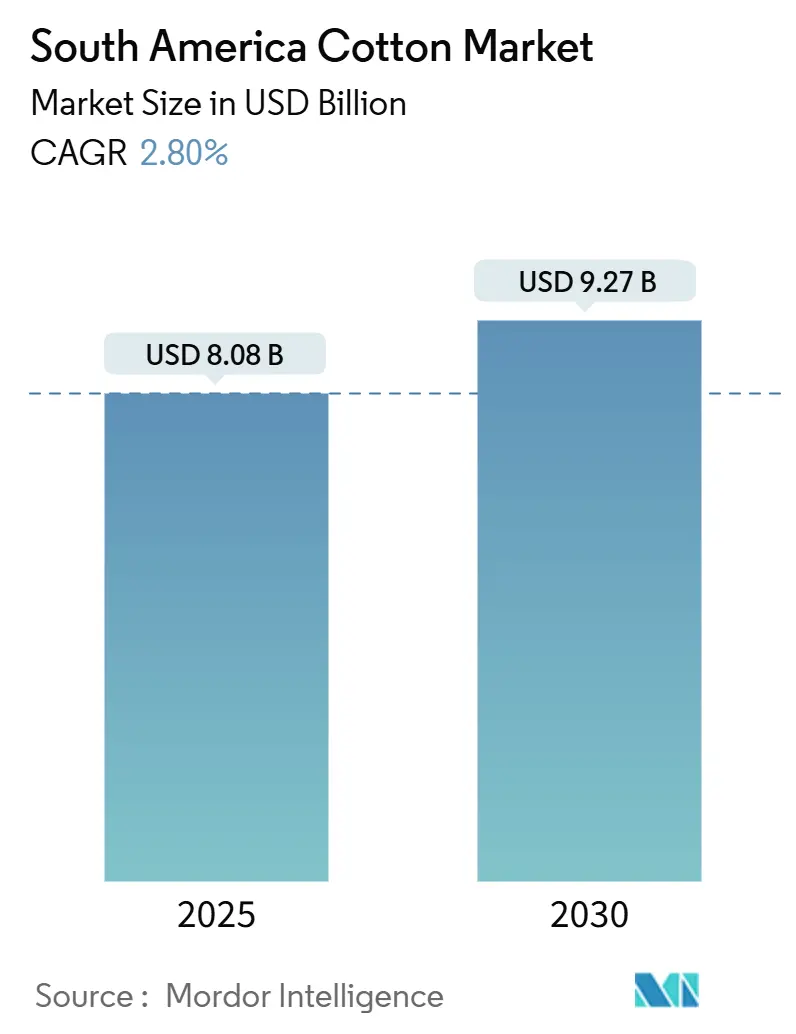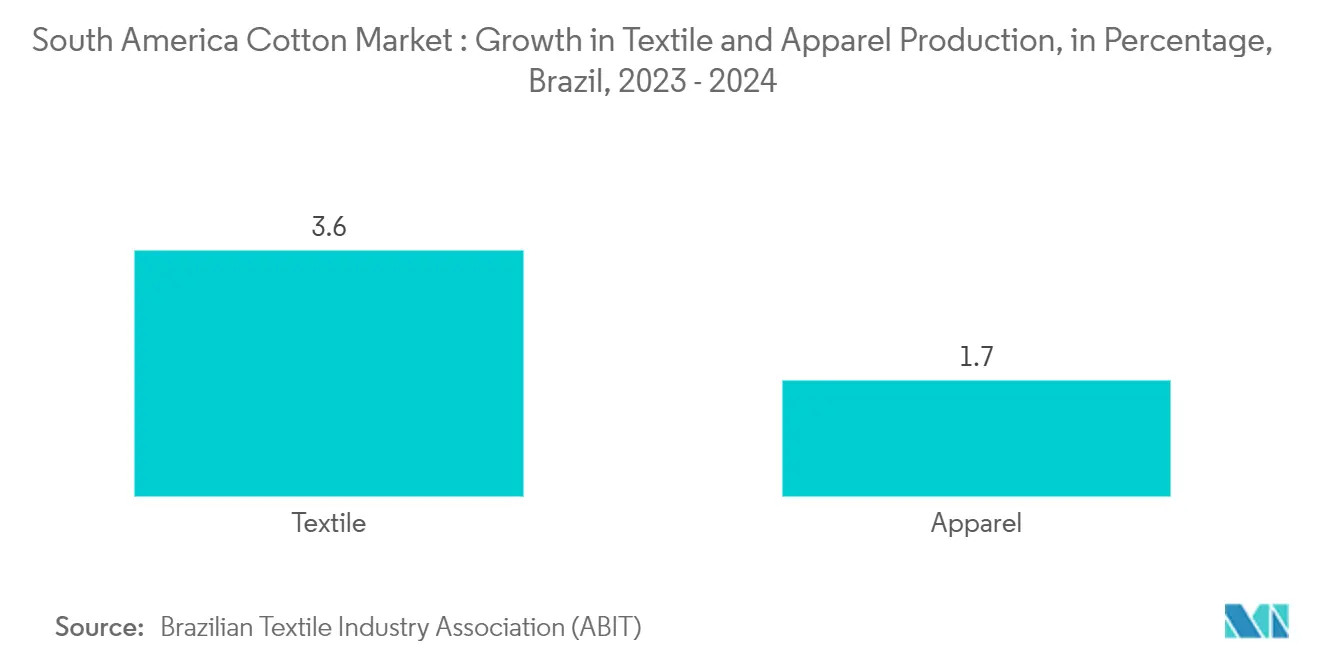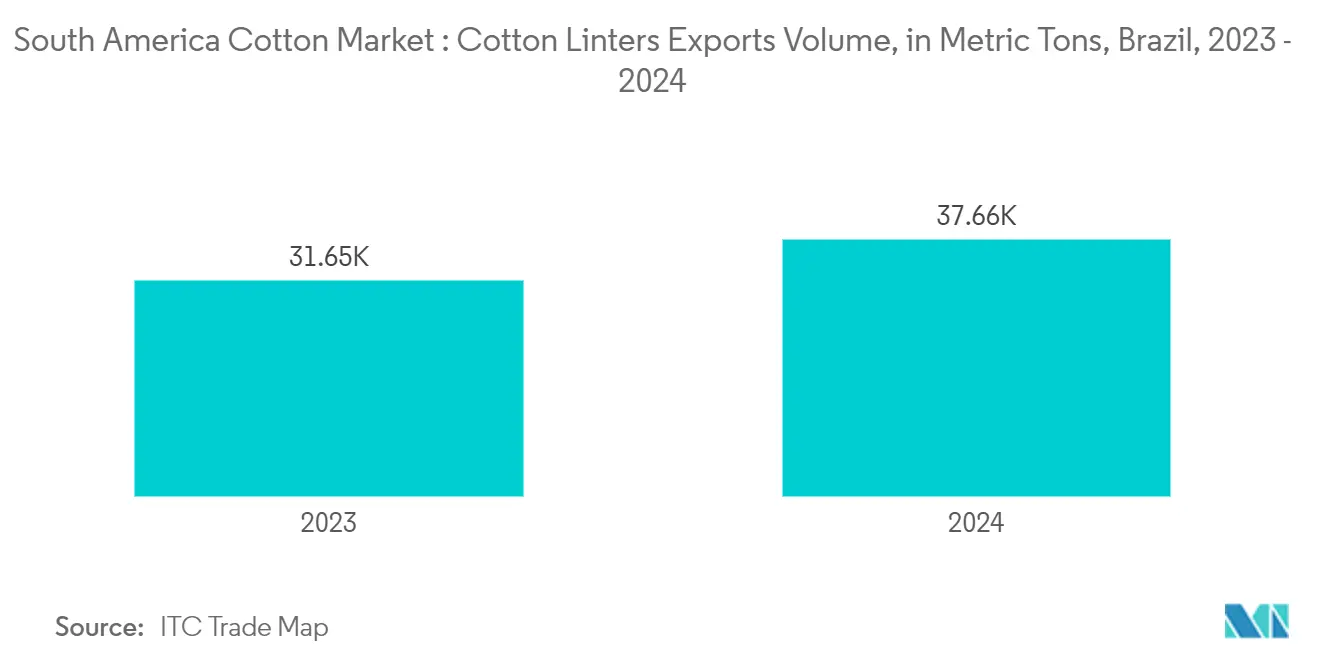
South America Cotton Market Analysis by Mordor Intelligence
The South America Cotton Market size is estimated at USD 8.08 billion in 2025, and is expected to reach USD 9.27 billion by 2030, at a CAGR of 2.80% during the forecast period (2025-2030).
Farm mechanization for cotton has become essential in major producing countries due to increased mechanization rates in cotton picking, limited land and water resources, and a declining labor force. The demand for cotton in both apparel and non-apparel sectors has shown significant growth in recent years. The textile industry significantly contributes to the global economy, supported by increasing cotton production in various regions. According to FAOSTAT, Brazil dominates South American cotton production with an 85% share, while Argentina accounts for 13.4% as of 2022. Brazil represents 14% of global cotton production and ranks among the top three world producers in MY 2024-2025, alongside China and India, as reported by USDA. ITC Trade Map data indicates that Brazil is the third-largest cotton exporter globally, holding a 16.7% export value share in 2023.
According to the United States Department of Agriculture (USDA) report, 2024, Cotton production in MY 2024/25 is forecast at 15.4 million bales (3.3 million metric tons), with Brazil's cotton area expanding to 1.87 million ha, representing a 13 percent increase from MY 2023/2024's 1.66 million ha. Output is projected to grow three percent from the previous MY's 14.9 million bales. Two factors drive this expansion. Declining corn prices relative to cotton have increased cotton cultivation in Mato Grosso, where it competes with second-crop corn. Additionally, severe heat waves and droughts in the Center-West region from October to December 2023 delayed soybean planting. As soybeans are Mato Grosso's preferred first crop, these delays impact subsequent corn and cotton cultivation patterns.
South America Cotton Market Trends and Insights
Increasing Demand from the Textile Industry
- Peru, Brazil, and Colombia stand out as key players in South America's textile industry. Leading the charge, Peru emerges as the continent's foremost clothing exporter. Meanwhile, Brazil, a top-ten global consumer of cotton, relies on its domestic cotton production, ensuring a consistent demand that bolsters its textile sector.
- Advancements in technologies like digital printing, sublimation, and the innovative Direct-to-Film (DTF) method are transforming the textile sector. According to Emitex 2025, The DTF method allows designs to be printed directly onto a thermoplastic film, which is then transferred onto fabric using heat and pressure. This technique not only ensures outstanding print quality but also boasts remarkable durability, making it a top choice for customized products. These technological strides are reshaping fabric production and opening up numerous business opportunities for both budding entrepreneurs and established firms, boosting efficiency and profitability in Argentina.
- According to the study “The Future of Digital Textile Printing for 2023,” digital printing offers unparalleled flexibility for fabric design reproduction. This capability enables designers and businesses to swiftly produce high-quality, personalized garments. Furthermore, digital printing not only cuts production costs but also facilitates shorter product runs. This approach minimizes excess waste and leads to a 40% reduction in CO2 emissions when compared to traditional methods. Therefore the demand for textiles is anticipated to boost the market growth in the coming years.

Brazil Dominates the Export Market
- Brazil holds a dominant position as South America's leading cotton exporter and ranks third globally, with 56% of its production directed to international markets. The country's primary export destinations include China (51.1%), Japan (31.6%), and Spain (14.6%) based on 2024 import value share according to the ITC Trade Map. Within South America, Argentina and Paraguay also participate in cotton exports, while the United States serves as a significant import partner for Brazil.
- Brazil has achieved a significant milestone by surpassing the United States as the world's largest cotton exporter, with its 2023-2024 harvest exceeding 3.7 million tons. This development, announced at the 75th meeting of the Cotton and Its Derivatives Sectoral Chamber in Bahia, occurred well ahead of the projected 2030 timeline, reflecting Brazil's improvements in production quality, traceability, and sustainability practices.
- The robust connection with the domestic textile industry has enhanced Brazil's competitive position while increasing local consumption, which is anticpated to rise from 750 thousand to 1 million tons annually. Additionally, 84% of Brazil's cotton production carries social and environmental sustainability certification. With growing demand from major markets including China, Vietnam, Bangladesh, Turkey, and Pakistan, Brazil is projected to export over 2.4 million tons in 2025, according to the Brazilian Confederation of Agriculture and Livestock (CNA).

Recent Industry Developments
- March 2025: Brazil's 2025 cotton planting area is projected to reach 2,091,974 hectares, marking a 3.2% increase from last month's estimate and a 0.2% rise compared to last year's figures, according to the Brazilian Institute of Geography and Statistics (IBGE).
- May 2024: Louis Dreyfus Company (LDC) has expanded its cotton ginning plant in Quimilí, Argentina, increasing its annual processing capacity to 60,000 metric tons. The investment includes advanced technology to optimize ginning services, double storage capacity, and utilize 100% raw cotton, aligning with LDC's sustainability goals. This marks the plant's 10th season under LDC management.
South America Cotton Market Report Scope
Cotton is a soft, fluffy staple fiber that grows in a protective case called a boll around the seeds of cotton plants belonging to the genus Gossypium in the Malvaceae family. The textile industry extensively uses cotton as a primary cash crop.
The South American cotton market is geographically segmented into Brazil, Argentina, and other countries. The market analysis encompasses production volume, consumption metrics (value and volume), export statistics (value and volume), import data (value and volume), and price trends. The market size and forecasts are presented in USD thousand (value) and metric tons (volume) across all segments.
| Brazil | Production Analysis |
| Consumption Analysis and Market Value | |
| Import Market Analysis (Volume and Value) | |
| Export Market Analysis (Volume and Value) | |
| Price Trend Analysis | |
| Argentina | Production Analysis |
| Consumption Analysis and Market Value | |
| Import Market Analysis (Volume and Value) | |
| Export Market Analysis (Volume and Value) | |
| Price Trend Analysis | |
| Others | Production Analysis |
| Consumption Analysis and Market Value | |
| Import Market Analysis (Volume and Value) | |
| Export Market Analysis (Volume and Value) | |
| Price Trend Analysis |
| Geography | Brazil | Production Analysis |
| Consumption Analysis and Market Value | ||
| Import Market Analysis (Volume and Value) | ||
| Export Market Analysis (Volume and Value) | ||
| Price Trend Analysis | ||
| Argentina | Production Analysis | |
| Consumption Analysis and Market Value | ||
| Import Market Analysis (Volume and Value) | ||
| Export Market Analysis (Volume and Value) | ||
| Price Trend Analysis | ||
| Others | Production Analysis | |
| Consumption Analysis and Market Value | ||
| Import Market Analysis (Volume and Value) | ||
| Export Market Analysis (Volume and Value) | ||
| Price Trend Analysis | ||
Key Questions Answered in the Report
How big is the South America Cotton Market?
The South America Cotton Market size is expected to reach USD 8.08 billion in 2025 and grow at a CAGR of 2.80% to reach USD 9.27 billion by 2030.
What is the current South America Cotton Market size?
In 2025, the South America Cotton Market size is expected to reach USD 8.08 billion.
What years does this South America Cotton Market cover, and what was the market size in 2024?
In 2024, the South America Cotton Market size was estimated at USD 7.85 billion. The report covers the South America Cotton Market historical market size for years: 2019, 2020, 2021, 2022, 2023 and 2024. The report also forecasts the South America Cotton Market size for years: 2025, 2026, 2027, 2028, 2029 and 2030.
Page last updated on:
South America Cotton Market Report
Statistics for the 2025 South America Cotton market share, size and revenue growth rate, created by Mordor Intelligence™ Industry Reports. South America Cotton analysis includes a market forecast outlook for 2025 to 2030 and historical overview. Get a sample of this industry analysis as a free report PDF download.


